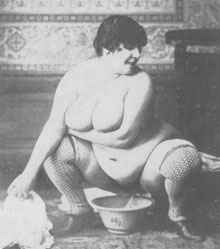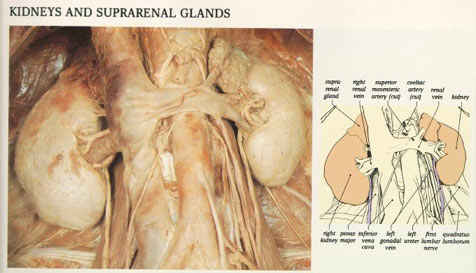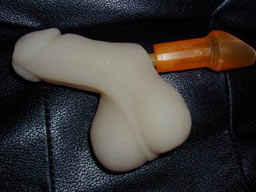|
Pissing With all the things that divide the human race—religions, sexual mores, income levels, and various other diversities of life experience—it's useful to reflect on those things which we all have in common. And simply put, everybody pees. Oddly enough however, not everyone is completely clear on how we create pee nor on what exactly pee is.
With all the things that divide the human race—religions, sexual mores, income levels, and various other diversities of life experience—it's useful to reflect on those things which we all have in common. And simply put, everybody pees. Oddly enough however, not everyone is completely clear on how we create pee nor on what exactly pee is.
First of all, what is pee? Contrary to the belief that urine is an icky toxic spew loaded with germs and poisons, human urine—when fresh—is virtually sterile. Of course it can pick up germs lurking in your urethra or genitals. Which is why doctors always insists that before giving a specimen you wash your genitals then let your pee stream run into the toilet for a bit, before collecting urine midstream in the specimen cup. And we should also note that certain viruses, such as Hepatitis B can also joyride in the urine of infected individuals. However, these exceptions aside, urine is regarded as sterile enough, and antiseptic enough to be used in cleaning wounds (in the absence of more conventional agents). As for toxicity, many humans and certain animals regard human urine as a perfectly acceptable and even highly desirable beverage. This seems less surprising when you consider that human urine is actually 95% water. Only a tiny 2.5% is urea (which could be harmful in very large doses), while the remaining 2.5% consists of salt and other minerals (magnesium, calcium, potassium, etc.), vitamins (including vitamin C and B-complex), trace amounts of ammonia, plus an admixture of various hormones and enzymes. Most people would probably never consider that more personal ingredients can creep into the urine in very tiny amounts, such as mucous and cells from the lining of the bladder and urethra, blood protein, and semen. In fact, among practioners of tantric yoga, or more specifically among men who orgasm without ejaculating, significant amounts of semen retrogrades into the bladder. Even women may secrete an ejaculatory substance in their urine after orgasm. Which could explain why some women squirt when they come and some women don't. Like certain men, they may experience retrograde ejaculation. Kind of makes you want to get out that microscope and some Dildos and do a little experimenting. While you may or many not have noticed sexual fluid in your urine, you've no doubt noticed that a few other things that sneak into this final 2.5%, such as bright yellow vitamin glow (Vitamin B2), coffee odor, traces of your favorite recreational drug (including caffeine and alcohol), and the legendary asparagus stink (due of course to eating asparagus). Incidentally, the mundane mellow yellow of ordinary pee comes from urochrome, a substance which comes from the breakdown of hemoglobin. If it were not for urochrome, writing your name in pee in the snow would not be nearly so much fun. Come to think of it, you might find it useful to know that alternative pee colors can be produced by ingesting indigo dye or methylene blue (for blue pee); rhubarb, cascara, and senna (brown, if your pee is acidic, or pink, if your pee is alkali); L-Dopa (dark brown); and the wormwood ingredient santonin (more pink for alkaline pee). Lastly, a few people can even produce red pee by eating beets. All this leads one to wonder, if you and your buddy cross streams in the snow, could you get a new color combination? Remember, blue and red make purple. While what you ingest by way of food and drink certainly influences the composition of your pee, the very nature by which pee is produced plays it's role as well. Since urine is 95% water, it is fair to say that the bulk of your urine actually begins its life in your large intestine. For while some substances (like alcohol) can be absorbed directly into the lining of the stomach, and while most nutrients are absorbed in the small intestine, it is in your large intestine where the liquids in your food and drink are absorbed into the blood stream.
Of course it would be silly to say that at this very moment you have pints and pints of pee whizzing around in your blood stream. Technically, your pee does not become pee until it is removed from the bloodstream by the kidneys.
While many people feel confused about the role of the kidneys (especially vis a vis the liver and more mysterious organs like the gall bladder, the pancreas, and so on), the true job of the kidneys is to regulate the composition of the blood—including regulating fluid levels. Not enough water in your blood stream (as on a hot summer's day), and your kidneys will remove very little. Too much fluid, and the kidneys will make the proper adjustments, skimming off the excess and earmarking it for urination. Just how this is done is as follows: the blood plasma filters through in the capillaries where pressure forces liquid out of the capillary walls into tiny little tubules within the kidney itself. (The cells and proteins remain in the blood stream, much like your macaroni remains in the pasta strainer as the hot water runs out.) There, within the tubules most of the water, glucose, salts, and other nutrients are reabsorbed. But the remaining excess journeys on through the tubules and is sent off through the ureters. Note that while you have one heart and one liver, you have two kidneys, located one on each side of your lower back. Each kidney has a long ureter tube which transports the urine to the bladder. From here on, most people are familiar with the process. The bladder fills. At a certain point, you begin to notice an increasing sense of pressure and urgency, signaling that the stretchy bag collecting your pee can hold no more. It's time for micturation—also known as urinating, going potty, peeing, pissing, piddling, whizzing, tinkling, easing yourself, seeing a man about a dog, draining the weasel, taking a leak, making a pit stop, and various other colorful phrases. While the basic biological function of peeing is the same for almost every man, woman, and child on the planet (excepting some variation due to disease or birth defect), attitudes toward pee and peeing vary greatly. Even how people pee varies from culture to culture. For example, you might assume (wrongly) that all men stand to pee while all women squat to pee. But in actual fact there are cultures both men and women squat (many Muslims consider pee contaminating and prefer to squat so as to avoid any potential for spattering or splattering), cultures in which both men and women stand, and even cultures in which men squat to pee while women stand to do their business. For example, according to the late 19th Century ethnographer John G. Bourke, aboriginal Australian men (of that era) squatted to pee, while among natives of Angola, Africa, both men and women stood to pee. Bourke also recorded that old Swiss women stand to pee, and that among the Native American Apaches, men sat and women stood.
What makes all this debate truly hilarious is the growing numbers of non-transsexual guys who want to sit down to pee—so that the urine that dribbles out their piercing holes doesn't get all over the place. (Somebody didn't plan ahead.) No doubt most of the guys who've opted for penis piercings thought they were embarking on a bold new life style. But few probably realized that their most political moment would come in the bathroom, when, in sitting down to pee, they would daily thumb their noses (or penises) at conventional gender morality. All of this brings us 'round full circle to our opening thoughts about the conflicted nature of humanity. Clearly we see that on something so trivial, and so universal, as peeing we still can't keep from elaborating on our differences and blowing them out of proportion.
Timeline
Drinking Pee
|

 As we contemplate these variances on what most Americans take as standard (men standing, women sitting), it's fun to notice some added twists contributed to the story, in this case by largely by members of our own modern culture. Most obviously of course, there are the various members of the transsexual population. Among these we have male to female transsexuals—some of whom have gone the whole way and had their willy whacked off and some of whom have not. Meanwhile, we have female to male transexuals, none of whom is likely to ever have a fully functional penis grafted onto their original equipment. Because American society is so obsessed with gender roles and all that goes with them, American transsexuals have suffered considerable angst over their inability to "perform"—not in the bedroom, but in the public restroom. Surf the web and you will find countless ruminations on the problems of passing at the pisser. Advice on how to pee standing up (sans penis) war against impassioned manifestos that cry "Whose business is it anyway! I'm sitting down—and I don't care what you think about it!", embellished by seemingly whispered advice about how to pee in the stall without looking like a sissy-wierdo-obvious-transsexual.
As we contemplate these variances on what most Americans take as standard (men standing, women sitting), it's fun to notice some added twists contributed to the story, in this case by largely by members of our own modern culture. Most obviously of course, there are the various members of the transsexual population. Among these we have male to female transsexuals—some of whom have gone the whole way and had their willy whacked off and some of whom have not. Meanwhile, we have female to male transexuals, none of whom is likely to ever have a fully functional penis grafted onto their original equipment. Because American society is so obsessed with gender roles and all that goes with them, American transsexuals have suffered considerable angst over their inability to "perform"—not in the bedroom, but in the public restroom. Surf the web and you will find countless ruminations on the problems of passing at the pisser. Advice on how to pee standing up (sans penis) war against impassioned manifestos that cry "Whose business is it anyway! I'm sitting down—and I don't care what you think about it!", embellished by seemingly whispered advice about how to pee in the stall without looking like a sissy-wierdo-obvious-transsexual.